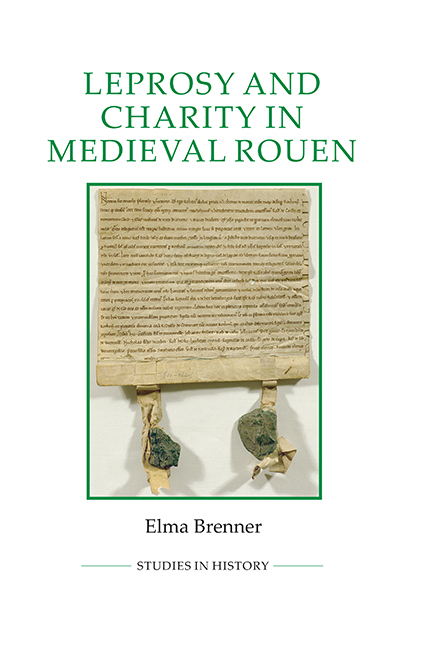Book contents
- Frontmatter
- Dedication
- Contents
- List of Illustrations
- Acknowledgements
- Abbreviations
- Introduction: Leprosy, Charity and Rouen
- 1 Rouen’s Principal Leper House: Mont-aux-Malades and Its Endowment
- 2 Charity and Community at Mont-aux-Malades
- 3 Rouen’s Other Leper Houses: Institutions, Gender and Status
- 4 Leprosy and the Medical World of Rouen
- 5 Leprosy and the Religious Culture of Rouen
- Conclusion
- Appendix 1 A Note on Sources
- Appendix 2 Charters and other Documents Relating to Leprosy in Rouen, c. 1100–c. 1500
- Bibliography
- Index
Introduction: Leprosy, Charity and Rouen
Published online by Cambridge University Press: 07 May 2022
- Frontmatter
- Dedication
- Contents
- List of Illustrations
- Acknowledgements
- Abbreviations
- Introduction: Leprosy, Charity and Rouen
- 1 Rouen’s Principal Leper House: Mont-aux-Malades and Its Endowment
- 2 Charity and Community at Mont-aux-Malades
- 3 Rouen’s Other Leper Houses: Institutions, Gender and Status
- 4 Leprosy and the Medical World of Rouen
- 5 Leprosy and the Religious Culture of Rouen
- Conclusion
- Appendix 1 A Note on Sources
- Appendix 2 Charters and other Documents Relating to Leprosy in Rouen, c. 1100–c. 1500
- Bibliography
- Index
Summary
Leprosy has a prominent place in the modern-day imagination of the Middle Ages. There is much interest in how such a shocking disease, which has now disappeared from Western Europe, affected medieval society. The appearance of lepers in works of art, literature and miracle accounts, as well as the material remains of leper houses, testify to the contemporary cultural impact of the disease, despite the fact that only a very small proportion of the population actually contracted it. In the area around Rouen, one of the leading cities of medieval Western Europe, several leprosaria were established in the twelfth and thirteenth centuries, the most prominent being Mont-aux- Malades and Salle-aux-Puelles. Leprosy and its sufferers had a distinctive impact on the society and religious culture of Rouen between the twelfth and fifteenth centuries. A detailed study of the city's leper houses thus sheds light on the social relationships and networks that shaped economic, political and devotional life in the city, and on changing responses to sickness and disease in this period. It also demonstrates the significant contribution made by the practice of charity, not only to provision for the sick and needy, but also to the forging of reciprocal bonds between different social groups.
Leprosy
Responses to leprosy in medieval Europe were complex and often contradictory, reflecting the complicated moral and religious associations of the disease. Until the 1990s, scholarship tended to argue that lepers were socially excluded and stigmatised, and that leprosy was viewed as a punishment for sin. In more recent decades, however, this viewpoint has been assessed critically, and has been traced back to the nineteenth century, when colonial encounters with lepers in extra-European settings influenced perspectives on medieval leprosy. It has been suggested that, instead, the leprous had a special religious status in the Middle Ages, being believed to have been chosen by God to be redeemed, and were thus the objects of sympathy and compassion. Historians have also pointed towards the manners in which lepers were integrated, rather than segregated. Admittedly, leper houses were almost always situated outside towns and cities, apparently following the biblical instruction that lepers should live ‘without the camp’ (Leviticus xiii.46). Yet these institutions remained connected to mainstream society as a key focus of charity, as well as through their economic activities as property-holders and centres of agricultural production.
- Type
- Chapter
- Information
- Leprosy and Charity in Medieval Rouen , pp. 1 - 18Publisher: Boydell & BrewerPrint publication year: 2015

